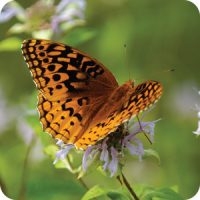How to Enjoy Butterflies

Experts agree, habitat for butterflies is being reduced. This means not only the places butterflies live and reproduce is being reduced, but the places they find food is also being reduced. Anything people can do to help butterflies is important. You can encourage butterflies at all stages to frequent your yard by creating butterfly habitats.
The most important concerns for butterflies are the basic habitat components. Butterflies can be attracted by offering food, water and shelter. They need nectar plants and host plants. Host plants (plants that the eggs are laid upon and that the caterpillar eats) seem to be the most important component. Monarch butterflies have a direct relationship with milkweed. The eggs are laid and hatch within four to five days. The yellow, white and black striped caterpillars have a voracious appetite and eat the leaves. The silvery blue butterfly lays its eggs on wild pea blossoms. The cabbage white caterpillars munch on cabbage and broccoli. Nectar plants are flowering plants which provide a food source for the adult butterflies. Butterflies will feed from plants that provide nectar.
They will also feed from feeders. Butterflies, such as the Red Admiral, Painted Lady, Tiger Swallowtail and Mourning Cloak in particular, will feed from a butterfly nectar feeder. The recommended nectar solution is one (1) part sugar to 18 parts water. Butterflies are attracted to natural sources of food and the most successful means of feeding seems to be rotten fruit placed on top of the feeder. Bananas, pears and other juicy fruits can be used.
Host plants include trees, bushes and many domestic and wildflowers. Butterfly hibernation boxes are filled with long strips of bark that the butterflies use for clinging. They can be used as a roost in the summer months as well and as a shelter in the winter months. However, there are very few documented reports of butterflies actually over-wintering in hibernation boxes. While a few species over winter as adults, a larger number of species over winter as eggs, larva, or pupae. Check for the butterfly species in your area so can provide the host and nectar plants that may be best for them.
Butterflies are a part of our ecosystem; they pollinate crops and plants and provide beauty and joy to many people’s lives. It may take years to establish a butterfly area; be patient and enjoy.

